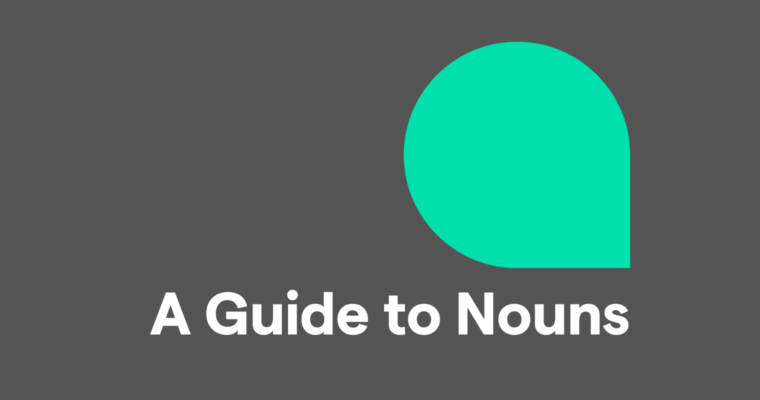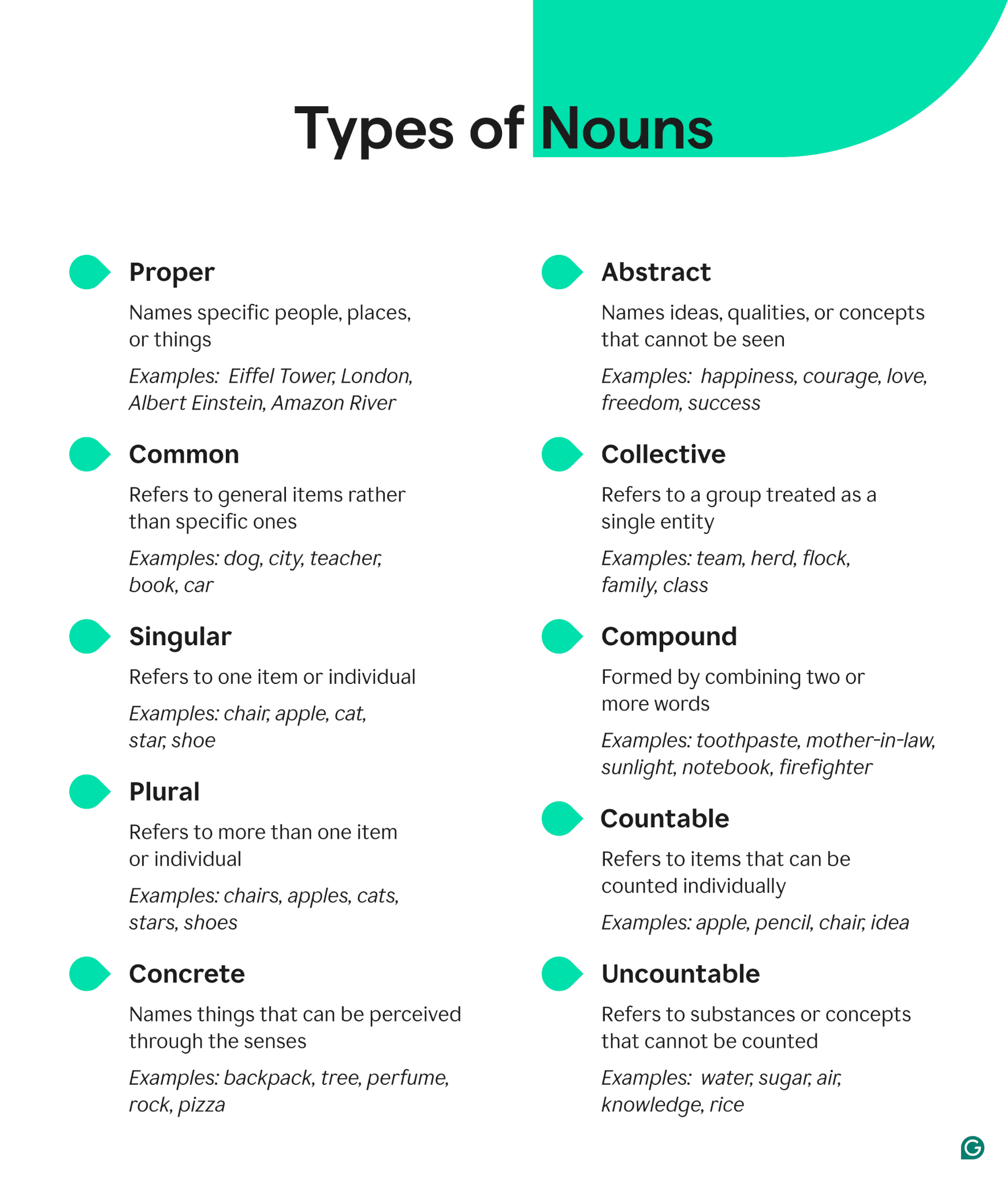
- A noun is a word that names something, such as a person, place, thing, or idea.
- In a sentence, nouns can play the role of subject, direct object, indirect object, subject complement, object complement, appositive, or modifier.
- Proper nouns refer to specific names and are capitalized (Yellowstone), while common nouns are general and lowercase (park).
- Singular nouns name one thing (cat); plural nouns name more than one thing (cats); and possessive nouns indicate ownership (cat’s toy).
- Concrete nouns refer to physical objects perceived by senses (doorbell); abstract nouns refer to intangible concepts (freedom); and collective nouns refer to groups considered as one entity (team).
- Countable nouns can be pluralized (two apples), while uncountable nouns represent masses or concepts (water).
Nouns are everywhere in our writing. But what are the different types of nouns, and how do you use them? Here, we’ll explain what nouns are using rules and examples to demonstrate.
Table of contents
Countable nouns vs. uncountable nouns
Noun definition
Nouns are words that identify people, places, things, or ideas. As one of the fundamental building blocks of language, they allow us to identify and discuss everything in our world, from tangible objects like book and tree to intangible ideas like freedom and happiness.
Without nouns, language would lack the essential tools to label and describe the subjects and objects of our sentences.
Nouns can name a person
Nouns can name a place
Nouns can name things
Things might include intangible things, such as concepts, activities, or processes. Some are hypothetical or imaginary things.
Types of nouns
Nouns are a large proportion of English vocabulary and come in a wide variety of types:
Types of common nouns
Common or generic nouns can be divided into three subtypes: concrete nouns, abstract nouns, and collective nouns.
Concrete nouns
A concrete noun is something that is perceived by the senses, something physical or tangible.
Doorbell and keyboard name real things that can be sensed.
Abstract nouns
An abstract noun is something that cannot be perceived by the senses.
Courage is an abstract noun. Courage can’t be seen, heard, or sensed in any other way, but we know it exists.
Collective nouns
A collective noun denotes a group or collection of people or things.
Pack, as used here, is a collective noun. Collective nouns take a singular verb, as they refer to the collection of people or things they identify as one entity—in this case, the singular verb is.
Pride is also a collective noun.
Proper nouns vs. common nouns
One important distinction is whether a noun is a proper noun or a common noun.
Proper nouns
A proper noun is a specific name of a person, place, or thing and is always capitalized.
Tina is the name of a specific person.
Old Faithful is the specific name of a geological phenomenon.
Common nouns
The opposite of a proper noun is a common noun, sometimes known as a generic noun. A common noun is the generic name of an item in a class or group. It is not capitalized unless it appears at the beginning of a sentence or in a title.
Girl is a common noun; we do not learn the girl’s identity by reading this sentence, though we know the action she takes. River is also a common noun in this sentence.
Singular vs. plural nouns
All nouns are either singular or plural in number. A singular noun refers to one person, place, thing, or idea and requires a singular verb, while a plural noun refers to more than one person, place, thing, or idea and requires a plural verb.
Forming plural nouns
Many English plural nouns can be formed by adding –s or –es to the singular form, although many exceptions exist.
Note the plural verb are.
Countable nouns vs. uncountable nouns
Concrete and abstract common nouns can be further classified as either countable or uncountable.
Countable nouns
Countable nouns can be counted, even if the resulting number would be extraordinarily high (like the number of humans in the world). Countable nouns can be singular or plural and used with numbers and modifiers like a/an, the, some, any, a few, and many.
Uncountable nouns
Uncountable nouns, or mass nouns, are nouns that are impossible to count, whether because they name intangible concepts (information, animal husbandry, wealth), collections of things that are considered as wholes (jewelry, equipment, the working class), or homogeneous physical substances (milk, sand, air).
Although most of these nouns are singular in form because they refer to things that can’t be isolated and counted on their own, they are never used with the singular indefinite article a or an.
Singular concrete uncountable nouns can often be expressed in countable units by adding a countable noun, like piece (with of). On their own, uncountable nouns can be modified by the definite article, the, or indefinite adjectives like some.
Gerunds: Verbs acting as nouns
A gerund is a verb form that ends in -ing and functions as a noun in a sentence. Despite their verb origins, gerunds are used to name activities or actions.
Gerunds can serve as subjects, objects, or complements:
- Subject: Reading improves your vocabulary.
- Direct object: She loves dancing.
- Object of a preposition: He is good at cooking.
Gerunds uniquely blur the line between nouns and verbs, making them essential for describing actions as concepts or activities.
Nouns and the possessive case
The possessive case shows the relationship of a noun to other words in a sentence. That relationship can be ownership, possession, occupancy, a personal relationship, or another kind of association.
Possessive case of singular nouns
The possessive of a singular noun is formed by adding an apostrophe and the letter s.
The cat possesses the toy, and we denote this by using –’s at the end of cat.
Here, the possessive case indicates the relationship between Casey and their sister.
In the above example, the possessive case denotes that the novel is in the role of object in relationship to release; someone released the novel.
Possessive case of plural nouns
The possessive of a plural noun that ends in –s or –es is formed by adding just an apostrophe.
The possessive of an irregular plural noun is formed by adding –’s.
When a singular noun ends in the letter s or z, the general rule of adding –’s often applies.
However, this is a matter of style, and some style guides call for leaving off the s after the apostrophe.
Whichever style an organization or writer chooses should be used consistently.
Functions of nouns
Nouns take on different roles based on their relationships to the rest of the words in a sentence.
Nouns as subjects
Every sentence must have a subject, which will always be a noun or pronoun. The subject of a sentence is the person, place, or thing that is doing, being, or experiencing whatever is described by the sentence’s verb.
The noun Maria is the subject of this sentence; it tells us who is performing the action described by the sentence’s verb (played).
Nouns as objects
Nouns can also be objects of a transitive verb in a sentence. An object can be either a direct object (a noun that receives the action described by the verb) or an indirect object (a noun that receives a direct object).
In both sentences above, the noun salt is the direct object of the verb passed; the salt is what Cleo passed. The second sentence also has an indirect object: the noun Otto. Otto is the person to whom Cleo passed the salt; Otto is the recipient of the salt. A good way to identify an indirect object in a sentence is to ask yourself to whom/what or for whom/what something is being done.
Nouns as subject and object complements
Another role nouns sometimes perform in a sentence is that of a subject complement. A subject complement normally follows a linking verb such as be, become, or seem and gives more information about the subject of the sentence.
In this sentence, the noun teacher is being used as a subject complement. A teacher is what Mary is.
A related function of nouns is to act as an object complement, which provides more information about the direct object of a sentence with a transitive verb.
Husbands is a noun used as an object complement in this sentence. Verbs that denote making, naming, or creating are often followed by nouns behaving as object complements.
Nouns as appositives
A noun used as an appositive immediately follows another noun to further define or identify it. The second noun is in apposition to the first noun.
Michael is an appositive here, further identifying the noun phrase my brother. Appositives can be restrictive or nonrestrictive. In the above example, the fact that it is set off between commas suggests that Michael is nonrestrictive—that is, it could be left out of the sentence without omitting essential information about who is six years old.
In other words, we can surmise that Michael is the writer’s only brother; telling us his name is extra information about him. Here is a version of the same sentence where the appositive is used restrictively without being set off by commas:
In this case, the appositive Michael is providing information that is essential for narrowing down which brother the writer is telling us about. We can infer that they have multiple brothers, and understand that it is the one named Michael who is six years old.
Nouns as modifiers
Sometimes, nouns can be used to modify other nouns, functioning like adjectives. When they do this, they are often called attributive nouns.
Speed is normally a noun, but here it acts as an adjective to modify demon.
Noun FAQs
What are nouns?
Nouns refer to a person, place, thing, or idea. They serve as the subjects, direct objects, and indirect objects in a sentence, along with other roles.
What are some examples of nouns?
Nouns can be living things (Keanu Reeves or cat), places (beach or Detroit), things (ruler or PlayStation 5), or ideas (nihilism or the theory of evolution).
What are the different types of nouns?
Common nouns refer to general things (like parks), and proper nouns refer to specific things (like Yellowstone National Park). Nouns can also be plural or singular, depending on how many there are, countable or uncountable, and possessive or not possessive.
How do you identify a noun in a sentence?
Nouns often have articles (the, a, or an) before them in a sentence, but not always. Sometimes, you’ll see adjectives like red or some before nouns. Aside from the first word in a sentence, if a word is capitalized, it’s most likely a proper noun, such as a person’s name.







